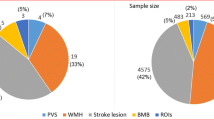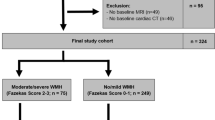Abstract
Cerebral microvascular angiopathy (MVA) is associated with clinical vascular risk factors and is characterised by histological changes, including thickening of the walls of arterial vessels and dilatation of the Virchow-Robin spaces (VRS). We have previously described two novel biomarkers of MVA based on magnetic resonance imaging (MRI), VRS dilatation and abnormalities in the transfer of systolic arterial pulsation to the ventricular CSF, which occur as a result of decreased cerebral arterial compliance. These are associated with vascular dementia and treatment-resistant late onset depression. We studied a group of normal subjects at risk of cerebrovascular disease to determine if these biomarkers are present in patients who have no evidence of symptomatic vascular disease. We studied 31 subjects, 16 with three or more vascular risk factors and 15 with one or less significant risk factors. We measured arterial blood flow and CSF flow in the cerebral aqueduct, white matter lesion load, and the distribution and number of VRS. There were significant differences in CSF pulsatility and in VRS in the basal ganglia between the two groups, but no differences in white matter lesion load. We conclude that asymptomatic subjects at risk of stroke have MRI evidence of MVA before white matter lesions become apparent.


Similar content being viewed by others
Notes
Leng GC, Fowkes FG (1992): The Edinburgh Claudication Questionnaire: an improved version of the WHO/Rose questionnaire for use in epidemiological surveys. J Clin Epidemiol 10:1101–9
References
Gallego J, Martinez-Vila E (2005) Asymptomatic cerebrovascular disease and systemic diagnosis in stroke, atherothrombosis as a disease of the vascular tree. Cerebrovasc Dis 20(Suppl 2):1–10
Hommel M, Gray F (1995) Microvascular pathology. In: Caplan L (ed) Brain ischaemia: Basic concepts and clinical relevance. Springer Verlag Berlin, New York, pp 215–223
Thomas AJ, O’Brien JT, Davis S et al (2002) Ischemic basis for deep white matter hyperintensities in major depression: a neuropathological study. Arch Gen Psychiatry 59:785–792
Thomas AJ, Perry R, Barber R et al (2002) Pathologies and pathological mechanisms for white matter hyperintensities in depression. Ann N Y Acad Sci 977:333–339
Thomas AJ, Perry R, Kalaria RN et al (2003) Neuropathological evidence for ischemia in the white matter of the dorsolateral prefrontal cortex in late-life depression. Int J Geriatr Psychiatry 18:7–13
Krishnan KR, McDonald WM (1995) Arteriosclerotic depression. Med Hypotheses 44:111–115
Krishnan KR, Hays JC, Blazer DG (1997) MRI-defined vascular depression. Am J Psychiatry 154:497–501
Alexopoulos GS, Meyers BS, Young RC et al (1997) ‘Vascular depression’ hypothesis. Arch Gen Psychiatry 54:915–922
Greenwald BS, Kramer-Ginsberg E, Krishnan KR et al (2001) A controlled study of MRI signal hyperintensities in older depressed patients with and without hypertension. J Am Geriatr Soc 49:1218–1225
Thacker NA, Varma AR, Bathgate D et al (2002) Dementing disorders: volumetric measurement of cerebrospinal fluid to distinguish normal from pathologic findings – feasibility study. Radiology 224:278–285
Tian J, Shi J, Bailey K et al (2004) Relationships between arteriosclerosis, cerebral amyloid angiopathy and myelin loss from cerebral cortical white matter in Alzheimer’s disease. Neuropathol Appl Neurobiol 30:46–56
Purandare N, Burns A, Daly KJ et al (2006) Cerebral emboli as a potential cause of Alzheimer’s disease and vascular dementia: case-control study. Bmj 332:1119–1124
Patankar TF, Baldwin R, Mitra D et al (2007) Virchow-Robin space dilatation may predict resistance to antidepressant monotherapy in elderly patients with depression. J Affect Disord 97:265–270
Patankar TF, Mitra D, Varma A et al (2005) Dilatation of the Virchow-Robin space is a sensitive indicator of cerebral microvascular disease: study in elderly patients with dementia. AJNR Am J Neuroradiol 26:1512–1520
Naish JH, Baldwin RC, Patankar T et al (2006) Abnormalities of CSF flow patterns in the cerebral aqueduct in treatment-resistant late-life depression: a potential biomarker of microvascular angiopathy. Magn Reson Med 56:509–516
Scheltens P, Barkhof F, Leys D et al (1993) A semiquantative rating scale for the assessment of signal hyperintensities on magnetic resonance imaging. J Neurol Sci 114:7–12
Varma AR, Laitt R, Lloyd JJ et al (2002) Diagnostic value of high signal abnormalities on T2 weighted MRI in the differentiation of Alzheimer’s, frontotemporal and vascular dementias. Acta Neurol Scand 105:355–364
Purandare N, Oude Voshaar RC, Davidson Y et al (2006) Deletion/insertion polymorphism of the angiotensin-converting enzyme gene and white matter hyperintensities in dementia: A pilot study. J Am Geriatr Soc 54:1395–1400
Inzitari D, Carlucci G, Pantoni L (2000) White matter changes: the clinical consequences in the aging population. J Neural Transm Suppl 59:1–8
Rabbitt P, Scott M, Lunn M et al (2007) White matter lesions account for all age-related declines in speed but not in intelligence. Neuropsychology 21:363–370
Rabbitt P, Scott M, Thacker N et al (2006) Losses in gross brain volume and cerebral blood flow account for age-related differences in speed but not in fluid intelligence. Neuropsychology 20:549–557
Patankar T, Widjaja E, Chant H et al (2006) Relationship of deep white matter hyperintensities and cerebral blood flow in severe carotid artery stenosis. Eur J Neurol 13:10–16
Simpson S, Baldwin RC, Jackson A et al (2000) Is the clinical expression of late-life depression influenced by brain changes? MRI subcortical neuroanatomical correlates of depressive symptoms. Int Psychogeriatr 12:425–434
Simpson S, Baldwin RC, Jackson A et al (1998) Is subcortical disease associated with a poor response to antidepressants? Neurological, neuropsychological and neuroradiological findings in late-life depression. Psychol Med 28:1015–1026
Song CJ, Kim JH, Kier EL et al (2000) MR imaging and histologic features of subinsular bright spots on T2-weighted MR images: Virchow-Robin spaces of the extreme capsule and insular cortex. Radiology 214:671–677
Bokura H, Kobayashi S, Yamaguchi S (1998) Distinguishing silent lacunar infarction from enlarged Virchow-Robin spaces: a magnetic resonance imaging and pathological study. J Neurol 245:116–122
Braffman BH, Zimmerman RA, Trojanowski JQ et al (1988) Brain MR: pathologic correlation with gross and histopathology. 1. Lacunar infarction and Virchow-Robin spaces. AJR Am J Roentgenol 151:551–558
McEniery CM, Yasmin, Wallace S et al (2005) Increased stroke volume and aortic stiffness contribute to isolated systolic hypertension in young adults. Hypertension 46:221–226
Duprez DA, De Buyzere ML, Van den Noortgate N et al (2001) Relationship between periventricular or deep white matter lesions and arterial elasticity indices in very old people. Age Ageing 30:325–330
Scuteri A, Brancati AM, Gianni W et al (2005) Arterial stiffness is an independent risk factor for cognitive impairment in the elderly: a pilot study. J Hypertens 23:1211–1216
Stivaros SM, Jackson A (2007) Changing concepts of cerebrospinal fluid hydrodynamics: role of phase-contrast magnetic resonance imaging and implications for cerebral microvascular disease. Neurotherapeutics 4:511–522
Kim J, Thacker NA, Bromiley PA et al (2007) Prediction of the jugular venous waveform using a model of CSF dynamics. AJNR Am J Neuroradiol 28:983–989
Bateman GA (2002) Vascular hydraulics associated with idiopathic and secondary intracranial hypertension. AJNR Am J Neuroradiol 23:1180–1186
Bateman GA (2002) Pulse-wave encephalopathy: a comparative study of the hydrodynamics of leukoaraiosis and normal-pressure hydrocephalus. Neuroradiology 44:740–748
Bateman GA (2003) The reversibility of reduced cortical vein compliance in normal-pressure hydrocephalus following shunt insertion. Neuroradiology 45:65–70
Bateman GA (2004) Pulse wave encephalopathy: a spectrum hypothesis incorporating Alzheimer’s disease, vascular dementia and normal pressure hydrocephalus. Med Hypotheses 62:182–187
Derouesne C, Gray F, Escourolle R et al (1987) ‘Expanding cerebral lacunae’ in a hypertensive patient with normal pressure hydrocephalus. Neuropathol Appl Neurobiol 13:309–320
Hanon O, Forette F (2004) Prevention of dementia: lessons from SYST-EUR and PROGRESS. J Neurol Sci 226:71–74
Sulbaran TA, Silva ER, Maestre G (2002) Isolated systolic hypertension: a new challenge in medicine. J Hum Hypertens 16(Suppl 1):S44–S47
de Leeuw FE, de Groot JC, Bots ML et al (2000) Carotid atherosclerosis and cerebral white matter lesions in a population based magnetic resonance imaging study. J Neurol 247:291–296
de Leeuw FE, De Groot JC, Oudkerk M et al (2000) Aortic atherosclerosis at middle age predicts cerebral white matter lesions in the elderly. Stroke 31:425–429
Leng GC, Fowkes FG (1992) The Edinburgh Claudication Questionnaire: an improved version of the WHO/Rose Questionnaire for use in epidemiological surveys. J Clin Epidemiol 45:1101–1109
Acknowledgements
This study was funded by the Sir Jules Thorn Charitable Trust. PT, AJ, MS and NR are funded by the University of Manchester. We acknowledge the support of the Translational Imaging Unit staff, particularly Dr Lloyd Gregory and Mr Barry Whitnall.
Conflict of interest statement
None declared.
Author information
Authors and Affiliations
Corresponding author
Rights and permissions
About this article
Cite this article
Selvarajah, J., Scott, M., Stivaros, S. et al. Potential surrogate markers of cerebral microvascular angiopathy in asymptomatic subjects at risk of stroke. Eur Radiol 19, 1011–1018 (2009). https://doi.org/10.1007/s00330-008-1202-8
Received:
Revised:
Accepted:
Published:
Issue Date:
DOI: https://doi.org/10.1007/s00330-008-1202-8




